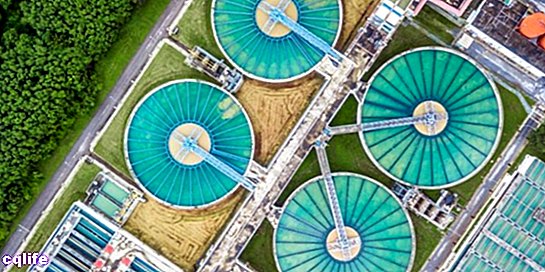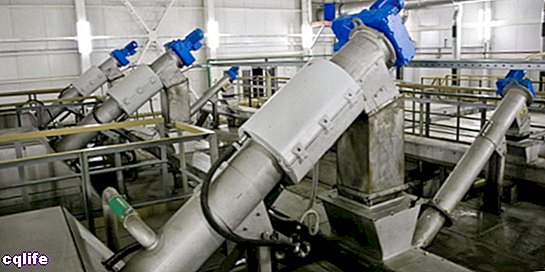- What is wastewater treatment?
- Sewage treatment plants
- Waste water pretreatment
- Stages of wastewater treatment
- Global water treatment deficit
We explain what wastewater treatment is, its stages and the plants that perform it. In addition, its deficit worldwide.

What is wastewater treatment?
It is known as wastewater treatment to the set of physical, chemical and biological procedures that allow to convert contaminated water into drinking water. Thus, the human being you can use it again.
Wastewater is produced daily, both in our homes, our jobs and in factories, industries and human activities of all kinds. They can be classified into:
- Wastewater. The ones we use to wash ourselves, clean our homes or go to the bathroom.
- Contaminated water. Those used by industries, factories, metallurgies or other production processes that convert some materials into others.
Although it is known that our planet is 70% of Water, it's not really a resource of which we can have unlimited and irresponsibly, so that wastewater treatment is imposed as a real necessity.
Wastewater can be treated in dedicated centers, known as wastewater treatment plants. They can also be treated preventively in the places of their use and contamination, through localized mechanisms and processes.
Its objective is to remove biological impurities from the water (bacteria, virus, organic material decomposing), chemical (chemical elements that alter its composition, metals heavy, etc.) or physical (dirt, dust, mud, etc.) and allow the treated water to be usable again.
Sewage treatment plants

They are known by this name or as purification plants to the facilities dedicated to the purification of waste water, using processes of different nature. There are as many types of plant as there are stages of water processing. Some carry out the entire process, while others focus only on specific moments of the purification.
Depending on the type, they can take place:
- Physical separations of water and waste solid that they may contain (without involving any type of reaction).
- Water treatment with various chemicals and reagents.
- The use of biological or biochemical reactions to counteract certain pollutants present in the liquid.
There are also special treatment plants, in which the specific presence of some pollutant punctual, according to regional conditions or industrial activities carried out. These types of treatments generally seek to correct the pH from the water and extract from it traces of compounds that would be toxic to those who consume them.
Waste water pretreatment

Pretreatment or primary treatment is the initial stage in the purification of wastewater. It is often carried out before they reach the treatment plant, or in the initial moments of the latter.
The process consists of separating the large and medium-sized solids that are in it (such as garbage, pebbles or plastics) by means of various lattice or sieving wefts, using sieves of varying thickness. Then sandblasters are applied to the water, to remove particles tiny pieces of sand that may be dissolved in it, and that sieves cannot filter.
The water, fat and oil that may have dissolved in the water are removed by applying special degreasing liquids. Finally, the water is retained for a time in special sedimentation containers and decantation, so that the gravity exert its attraction on the remaining solids and deposit them to the bottom, leaving the water free of them.
All this pretreatment serves to prepare the water for the formal start of its purification. In other words, it frees the water from objects that can obstruct the flow, damage the pipes, prevent or hinder the reactions to which it will be subjected in the following stages.
Stages of wastewater treatment

Once the pretreatment is completed, the wastewater continues on its way through two more stages, which are:
- Secondary or biological treatment. This stage aims to degrade the materials of organic origin that the water may contain, such as human or animal waste, detergents and soaps, bacteria and microorganisms, etc. For this, different techniques can be used:
- Roughing. A new stage of filtering or screening, using particularly fine sieves that retain the thickest fibers of organic origin, such as papers, fabrics, fabrics, etc.
- Activated sludge. Using microorganisms and added oxygen, the water is freed from nutrients and biological waste, including traces of metal, which are part of its metabolism.
- Beds of oxidation. This mechanism is little used today, in old plants generally, and consists of large seats of carbon, limestone or plastic, materials that promote the formation of biofilms of bacteria and protozoa that remove nutrients and organic residues from the water, through a system of rotating perforated arms.
- Biological reactors. Whether they are mobile bed or membrane bed, it is a technique that guarantees the elimination of biological nutrients present in the water that could sustain contaminating microbial life.
- Tertiary or chemical treatment. This is the final stage of the treatment, aimed at increasing the final quality of the water before being returned to the environment (sea, river, lake, etc.). This process may involve:
- Filtration. The water is filtered by making it pass through beds of sand, coal or other materials that retain the elements suspended and toxins that may have survived the secondary process.
- Lagoon. A successive process of "lagoons" or water stays, consisting of a first anaerobic, where the densest substances fall through gravity and the lack of oxygen kills certain life forms, then a facultative lagoon and finally a maturation lagoon. It is an efficient mechanism but it requires a lot of space.
- Nutrient removal. Since the treated waters, even at the end of the second treatment, retain high levels of nutrients such as nitrogen and phosphorus, which can promote the growth of algae and be toxic to fish and invertebrates, a biological oxidation is carried out using certain species of bacteria.
- Disinfection. Finally, to reduce the amount of organisms microscopic live in water, using various methods such as the addition of significant doses of chlorine, exposure to lethal doses of ultraviolet (UV) light or chemical bombardment with ozone (O3).
Global water treatment deficit
Since the 1970s, when the polluting effects of the human population explosion began to be seen, it has been known that a large percentage of diseases are directly related to the little or no sewage treatment policy of many countries.
However, even today the treatment of wastewater at a global level is much lower than that required to make our current existence sustainable, especially in less developed countries. According to UN estimates, in 2000 only 44% of the world's population had adequate wastewater treatment conditions.
